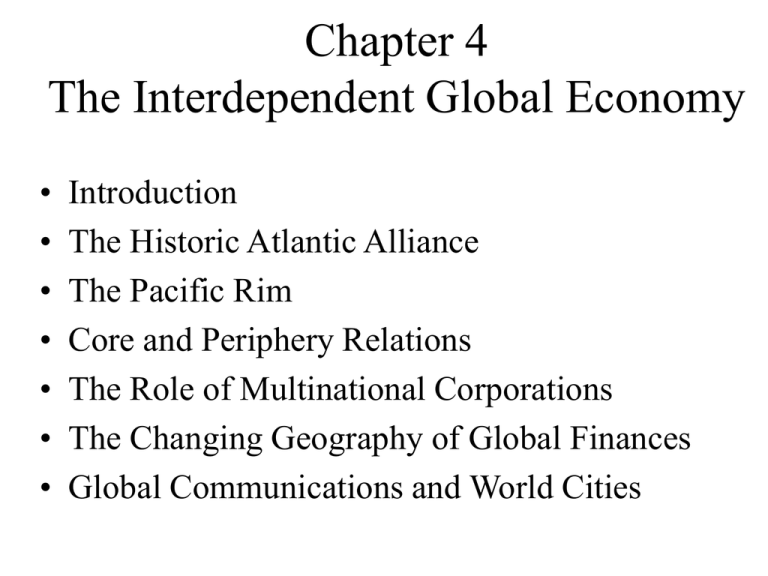Chapter 4 The Interdependent Global Economy
advertisement

Chapter 4 The Interdependent Global Economy • • • • • • • Introduction The Historic Atlantic Alliance The Pacific Rim Core and Periphery Relations The Role of Multinational Corporations The Changing Geography of Global Finances Global Communications and World Cities Gottman’s Quotation “Modern cities are the pillar’s of the developing global system. It is a poetic illusion to assume that the world is shrinking because communication improves. In reality the world of each of us constantly expands because, as we carry on, we find it necessary to deal with more and more people, in more places, with a greater number and diversity of problems. This is so for individuals and also for cities.” • Could be seen as another expression of Vance’s mercantilist model, or of Alonso’s bell-shaped development model • Historical characterization of European colonial empires to supply commodities needed in the industrial revolution Evolution of Global Trade • The Historic Atlantic Alliance - Domination of Atlantic trade in global trade • Post WW-II Pacific Rim Development Japan, 4 Tigers (S. Korea, Hong Kong, Taiwan, Singapore), Indonesia, Malaysia, China, Thailand (Table 4.2) • Figure 4.1 (U.S. Exports), Figure 4.2 (Japan exports), the Changing Position of China • New big trends: Movement of Mexican Maquiladora production to China; Outsourcing to India (English), Africa (French), E. Europe (German) Core and Periphery Relations (again) with more of a geopolitical spin • Wallerstein’s core-periphery hierarchy – Figure 4.3 – World Cities as the set of core focal points – His 4 epochs: (a) transitional period 1450-1640 (b) colonial capitalism (1640-1815) (c) British hegemony (1815-1917) (d) U.S. hegemony (1917- present) Marked by: U.S. Military superiority; socialist experiments, decolonialization of the periphery, rise of multinational corporations Dependency Theory • Core growth only possible by exploitation of the periphery • High levels of competition in primary producers, w/labor willing to work for low wages, in industries with depressed product prices, and a lack of internal investment to develop other industry in the internal economy. The Brain Drain • International Perspective in the text – (Japan vs. China) – The dramatically altered landscape since 9/11 • Could make the same arguments internally in countries, like the U.S. • Regional differences in education system capacity & consequences for income earning possibilities for residents. Location Quotients: S&E Graduate Students .66 Washington State Employers Import Educated Labor to a greater extent than expected due to the small local higher ed system The Role of Multinational Corporations • The rise of large corporations and increase in concentration of power • Types of market organization • Evolution of multi-establishment corporations • The ICI example in the text Alternative Models of Competition Barriers to Entry - High One Seller A Few Sellers Limited Quantity of Sellers Many Sellers One Buyer Monopsony A Few Buyers Oligopsony Many Buyers Monopoly Oligopoly Monopolistic Competition Perfect Competition Barriers to Entry - Low Attributes of Alternative Market Types Perfect Competition Homogeneoous products Each producer makes a small share of output No one seller influences Prices Entry to market is easy Flow of information is Perfect, eliminating excess profit Markets are fluid Monopoly Unique Product One producer makes all of the product Prices set to maximize profit High Barriers to Entry Monopolist is able to control the market Market is rigid “Pure” Monopoly Oligopoly Similar Products Several sellers divide the market Prices set through pricing strategies High Barriers to Entry Oligopolists engage in strategic behavior— competitive or collusive Market may be unstable, competitive strategies to create stability: product differentiation, advertising, industry agreements Trends in Business Concentration •“Concentration ratios” as indicators of market structure •Rising concentration in manufacturing in U.S. and U.K. over time •Similar trend in other sectors •Most industries are not monopolies, or perfectly competitive. The tendency is towards oligopoly AND often are part of multi-establishment firms, often conglomerates Size Distribution of Business Enterprises, U.S., 1997 0.1% of of Enterprises account foraccount 61% of 0.09% the businesses in the U.S. forReceipts 60% of total receipts Corporations Over $50 million Corporations $10-$49.9 million Corporations $5 - $9.9 million Net Income Corporations $1 - $4.9 million Receipts Number of Businesses Corporations less than $1 million Partnerships Non-Farm Proprietorships 0 5000 10000 15000 20000 Examples of Concentration Ratios Share in 1992 of Value Added accounted for by the largest companies, United States. 50 Largest 100 Largest 150 Largest 200 Largest 24% 32% 38% 42% Examples of Concentration Ratios SIC # of Companies 2421 5302 3334 30 3721 151 2011 1296 2013 1128 2015 373 2021 31 2022 418 2023 153 2024 411 2026 525 Value of Share of value of shipments Shipments accounted for by the x-largest companies: ($ millions) 4 8 20 50 21065 14 20 31 44 5849 59 82 99+ 100 62938 79 93 99 99+ 6959 50 66 79 88 5478 25 33 46 62 23845 34 45 66 85 1034 49 78 98 100 18344 42 60 74 86 7541 43 55 76 94 5291 24 40 68 87 21921 22 30 49 68 Evidence of Mergers and Divestitures United States 1985-1999 # 10000 $ 4000 8000 3000 6000 2000 4000 1000 2000 0 1985 1989 1990 1991 1992 1993 1994 1995 1996 1997 1998 1999 0 Number of Actions Value ($ Billions) Acquisitions and Divestitures, U.S., 1985-1999 # 7000 6000 5000 4000 Acquisitions Divestitures 3000 2000 1000 1999 1998 1997 1996 1995 1994 1993 1992 1991 1990 1989 1985 0 Consequences of Mergers, Acquisitions & Corporate Expansion • Most industries exhibit oligopolistic tendencies • Leading corporations are multiestablishment • Leading corporations are conglomerates • Leading corporations are multinationals • Truly global corporations now dominate international business: Table 4.4 “We live in a world of oligopolies, a world in which hundreds of thousands of small firms still exist but a relatively small number of large enterprises predominate.” P. 262, Lloyd & Dicken The constant flux in global (and local) corporations • Downsizing as a strategy • Outsourcing • “Re-engineering” AND • Simultaneously development of new businesses • Development of new product lines in existing businesses • Restructuring production locations K2 shifts work, cuts half of staff on Vashon (Seattle Times 11/19) “K2, a maker of skis and other sporting goods, said it will lay off half the workers at its Vashon Island plant as it moves half its ski and snowboard manufacturing to China and California and has suppliers make its bike products to cut costs.” “The company expects the changes to save $4 million next year.” “K2 makes skis, snowboards, inline skates and bikes under the K2 brand, as well as Olin skis and Shakespeare fishing tackle. It will move production to plants in Corona CA and China by year’s end.” “K2 got the Corona plant as part of its recent acquisition of Preston-based snowboard-equipment maker Ride. It will house manufacturing of mid- to high-end snowboards. The rest of the company’s products will be made in China or outsourced.” The Segmented Economy • Dynamics in Firm Populations • Averitt’s dual economy model Center firms - large, dominant, complex in organization, powerful resources and influence Peripheral firms - small, simple structures, weak resources, and little influence David Birch’s Thundercloud Big A few grow huge A small cohort become global corporations Size Most fall back after a short period Small Most Firms Many voluntary startups and stay small forever cessation's each year Birth Rates: ~ 10-12% of Existing Population Death Rate: ~ 8-10% of Opening Stock of Businesses A Model of the Segmented Economy by Taylor and Thrift BUSINESS ORGANIZATIONS Large Firms Smaller Firms Multidivisonal Leaders Laggards Intermediates Craftsman Subcontractors Global Satisfied Satellites Franchises Loyal Opposition Supports Laggards Intermediates Leaders Lindahl & Beyers test in the producer services Beyers & Lindahl Test of Segmented Industry In Producer Services Leaders High Fliers Still Growing, Exporters Still Growing, Local Right Industry Satellites & Spin-Offs Intermediates Field Offices Stabilizing Craftsman Proprietor Laggards Satisfied Small Business Steady Cruisers Declining Strugglers







